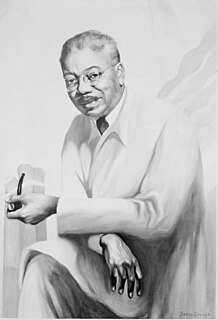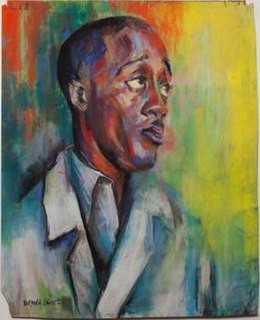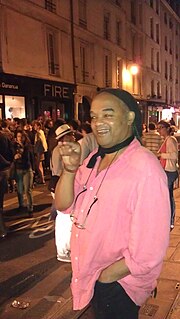
Charles Henry Alston was an American painter, sculptor, illustrator, muralist and teacher who lived and worked in the New York City neighborhood of Harlem. Alston was active in the Harlem Renaissance; Alston was the first African-American supervisor for the Works Progress Administration's Federal Art Project. Alston designed and painted murals at the Harlem Hospital and the Golden State Mutual Life Insurance Building. In 1990, Alston's bust of Martin Luther King Jr. became the first image of an African American displayed at the White House.

Jacob Armstead Lawrence was an American painter known for his portrayal of African-American historical subjects and contemporary life. Lawrence referred to his style as "dynamic cubism", although by his own account the primary influence was not so much French art as the shapes and colors of Harlem. He brought the African-American experience to life using blacks and browns juxtaposed with vivid colors. He also taught and spent 16 years as a professor at the University of Washington.

Aaron Douglas was an American painter, illustrator and visual arts educator. He was a major figure in the Harlem Renaissance. He developed his art career painting murals and creating illustrations that addressed social issues around race and segregation in the United States by utilizing African-centric imagery. Douglas set the stage for young, African-American artists to enter public arts realm through his involvement with the Harlem Artists Guild. In 1944, he concluded his art career by founding the Art Department at Fisk University in Nashville, Tennessee. He taught visual art classes at Fisk until his retirement in 1966. Douglas is known as a prominent leader in modern African-American art whose work influenced artists for years to come.
African-American art is a broad term describing the visual arts of the American black community. Influenced by various cultural traditions, including those of Africa, Europe and the Americas, traditional African-American art forms include the range of plastic arts, from basket weaving, pottery, and quilting to woodcarving and painting.

Beauford Delaney was an American modernist painter. He is remembered for his work with the Harlem Renaissance in the 1930s and 1940s, as well as his later works in abstract expressionism following his move to Paris in the 1950s. Beauford's younger brother, Joseph, was also a noted painter.

Gwendolyn Clarine Knight was an American artist who was born in Bridgetown, Barbados, in the West Indies.

The Indianapolis Museum of Art (IMA) is an encyclopedic art museum located at Newfields, a 152-acre (0.62 km2) campus that also houses Lilly House, The Virginia B. Fairbanks Art & Nature Park: 100 Acres, The Gardens at Newfields, the Beer Garden, and more. It is located at the corner of North Michigan Road and West 38th Street, near downtown Indianapolis, northwest of Crown Hill Cemetery. There are exhibitions, classes, tours, and events, many of which change seasonally. The entire campus was previously referred to as the Indianapolis Museum of Art, but in 2017 the campus and organization were renamed "Newfields" to better reflect the breadth of offerings and venues. The "Indianapolis Museum of Art" now specifically refers to the main art museum building that acts as the cornerstone of the campus, as well as the legal name of the organization doing business as Newfields.
Kerry James Marshall is an American artist and professor, known for his paintings of Black figures. He previously taught painting at the School of Art and Design at the University of Illinois at Chicago. In 2017, Marshall was included on the annual Time 100 list of the most influential people in the world. He was born and raised in Birmingham, Alabama and moved in childhood to South Central Los Angeles. He now lives in Chicago, Illinois.

Norman Wilfred Lewis was an American painter, scholar, and teacher. Lewis, who was African-American and of Bermudian descent, was associated with abstract expressionism, and used representational strategies to focus on black urban life and his community's struggles.
William T. Williams is an American painter. He is Professor of Art at Brooklyn College, City University of New York, whose faculty he joined in 1971.

Numbers 1-0 is a public artwork by the American artist Robert Indiana, located at the Indianapolis Museum of Art (IMA), which is near downtown Indianapolis, Indiana. This series of sculptures is composed of 10 brightly painted numerical digits, each made of aluminum and set on its own base. Their construction took place at the former Lippincott Foundry in North Haven, Connecticut from 1980 to 1983.
John Torreano is an American artist from Michigan. He is currently clinical professor of studio art at the Steinhardt School of Culture, Education, and Human Development at New York University. Torreano is known for utilizing faceted gems in a variety of mediums in order to create "movement oriented perception" in his works. Artist Richard Artschwager described Torreano's works as "paintings that stand still and make you move."

The Love Song is an oil painting by American artist Norman Rockwell, located in the Indianapolis Museum of Art, which is in Indianapolis, Indiana, United States. It originally appeared in the Ladies Home Journal in December 1926. It depicts two elderly musicians, on flute and clarinet, playing a duet while a young girl takes a break from sweeping to listen. The painting's title appears on the sheet music from which the musicians play.

Ealy Mays is a Paris-based African-American contemporary artist. His work has been exhibited in Mexico's Galeria Clave, Paris’ Carrousel du Louvre, Mexico's annual José Clemente Orozco Art competition, and New York's Guggenheim museum, to name a few. Legendary painter Henry O. Tanner was the first African American to exhibit at the Louvre in 1897. Mays’ 2005 “Migration of the Superheroes” exhibition at the Carrousel du Louvre makes him one of the few African-American artists to date to follow Tanner's footsteps to the Louvre.

Landscape near Arles is an 1888 oil painting by French artist Paul Gauguin, located in the Indianapolis Museum of Art, which is in Indianapolis, Indiana. It depicts a rural scene in Provence.

The Rainbow is an 1878 oil painting by American artist George Inness, located in the Indianapolis Museum of Art, which is in Indianapolis, Indiana. It depicts a rainbow arcing across the sky after a storm.

Rebecca and Eliezer at the Well is an oil painting by Italian artist Carlo Maratta, located in the Indianapolis Museum of Art, which is in Indianapolis, Indiana. It shows the story of Abraham's servant Eliezer giving Rebecca jewels to seal her betrothal to Isaac, after she had demonstrated the kindness foreseen by Abraham in offering water to Eliezer's camels.

Afternoon Tea is a 1910 oil painting by American artist Richard E. Miller, located in the Indianapolis Museum of Art, which is in Indianapolis, Indiana. Like many of Miller's paintings, it depicts women in a sunny scene, filled with flowers, depicted in his Impressionist style with a distinct flavor of Japonism.
Ronald Joseph (1910-1992) was an African-American artist, teacher, and printmaker.
Donald Judd's progression sculptures are a series of wall sculptures created between 1964 and the 1970s. Each work is similar in form, with Judd's choice of material varying depending on the date of production. Judd based each work on a simple mathematical sequence such as the Fibonacci Sequence. He typically called the works Untitled, sometimes adding the word progression to the title. Judd, along with fellow artists, Dan Flavin and Mel Bochner, was interested in the minimalist notion of seriality or serial progression rather than the more classical relational method of composition.














